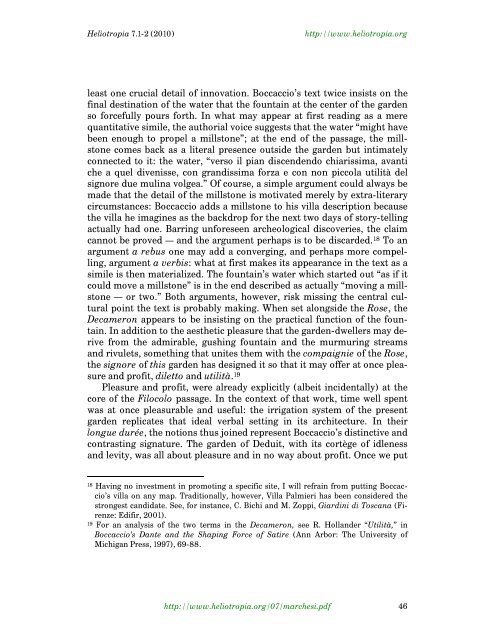Boccaccio's Vernacular Classicism: Intertextuality ... - Brown University
Boccaccio's Vernacular Classicism: Intertextuality ... - Brown University
Boccaccio's Vernacular Classicism: Intertextuality ... - Brown University
Create successful ePaper yourself
Turn your PDF publications into a flip-book with our unique Google optimized e-Paper software.
Heliotropia 7.1-2 (2010) http://www.heliotropia.org<br />
least one crucial detail of innovation. Boccaccio’s text twice insists on the<br />
final destination of the water that the fountain at the center of the garden<br />
so forcefully pours forth. In what may appear at first reading as a mere<br />
quantitative simile, the authorial voice suggests that the water “might have<br />
been enough to propel a millstone”; at the end of the passage, the millstone<br />
comes back as a literal presence outside the garden but intimately<br />
connected to it: the water, “verso il pian discendendo chiarissima, avanti<br />
che a quel divenisse, con grandissima forza e con non piccola utilità del<br />
signore due mulina volgea.” Of course, a simple argument could always be<br />
made that the detail of the millstone is motivated merely by extra-literary<br />
circumstances: Boccaccio adds a millstone to his villa description because<br />
the villa he imagines as the backdrop for the next two days of story-telling<br />
actually had one. Barring unforeseen archeological discoveries, the claim<br />
cannot be proved — and the argument perhaps is to be discarded. 18 To an<br />
argument a rebus one may add a converging, and perhaps more compelling,<br />
argument a verbis: what at first makes its appearance in the text as a<br />
simile is then materialized. The fountain’s water which started out “as if it<br />
could move a millstone” is in the end described as actually “moving a millstone<br />
— or two.” Both arguments, however, risk missing the central cultural<br />
point the text is probably making. When set alongside the Rose, the<br />
Decameron appears to be insisting on the practical function of the fountain.<br />
In addition to the aesthetic pleasure that the garden-dwellers may derive<br />
from the admirable, gushing fountain and the murmuring streams<br />
and rivulets, something that unites them with the compaignie of the Rose,<br />
the signore of this garden has designed it so that it may offer at once pleasure<br />
and profit, diletto and utilità. 19<br />
Pleasure and profit, were already explicitly (albeit incidentally) at the<br />
core of the Filocolo passage. In the context of that work, time well spent<br />
was at once pleasurable and useful: the irrigation system of the present<br />
garden replicates that ideal verbal setting in its architecture. In their<br />
longue durée, the notions thus joined represent Boccaccio’s distinctive and<br />
contrasting signature. The garden of Deduit, with its cortège of idleness<br />
and levity, was all about pleasure and in no way about profit. Once we put<br />
18 Having no investment in promoting a specific site, I will refrain from putting Boccaccio’s<br />
villa on any map. Traditionally, however, Villa Palmieri has been considered the<br />
strongest candidate. See, for instance, C. Bichi and M. Zoppi, Giardini di Toscana (Firenze:<br />
Edifir, 2001).<br />
19 For an analysis of the two terms in the Decameron, see R. Hollander “Utilità,” in<br />
Boccaccio’s Dante and the Shaping Force of Satire (Ann Arbor: The <strong>University</strong> of<br />
Michigan Press, 1997), 69-88.<br />
http://www.heliotropia.org/07/marchesi.pdf 46

















